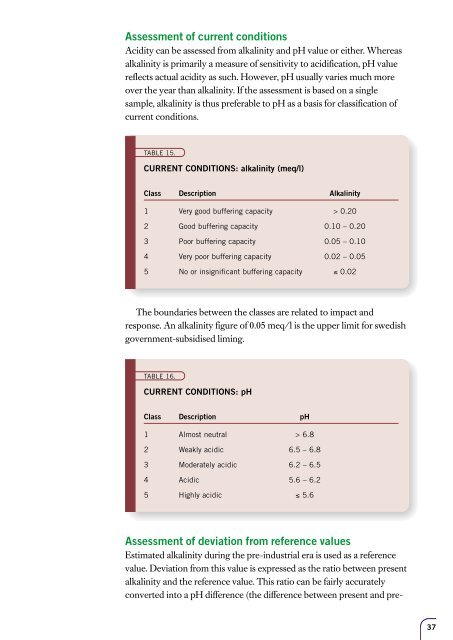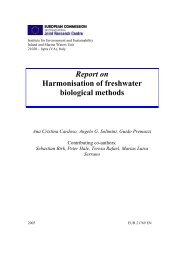Lakes and Watercourses
Lakes and Watercourses
Lakes and Watercourses
You also want an ePaper? Increase the reach of your titles
YUMPU automatically turns print PDFs into web optimized ePapers that Google loves.
Assessment of current conditions<br />
Acidity can be assessed from alkalinity <strong>and</strong> pH value or either. Whereas<br />
alkalinity is primarily a measure of sensitivity to acidification, pH value<br />
reflects actual acidity as such. However, pH usually varies much more<br />
over the year than alkalinity. If the assessment is based on a single<br />
sample, alkalinity is thus preferable to pH as a basis for classification of<br />
current conditions.<br />
TABLE 15.<br />
CURRENT CONDITIONS: alkalinity (meq/l)<br />
Class Description Alkalinity<br />
1 Very good buffering capacity > 0.20<br />
2 Good buffering capacity 0.10 – 0.20<br />
3 Poor buffering capacity 0.05 – 0.10<br />
4 Very poor buffering capacity 0.02 – 0.05<br />
5 No or insignificant buffering capacity ≤ 0.02<br />
The boundaries between the classes are related to impact <strong>and</strong><br />
response. An alkalinity figure of 0.05 meq/l is the upper limit for swedish<br />
government-subsidised liming.<br />
TABLE 16.<br />
CURRENT CONDITIONS: pH<br />
Class Description pH<br />
1 Almost neutral > 6.8<br />
2 Weakly acidic 6.5 – 6.8<br />
3 Moderately acidic 6.2 – 6.5<br />
4 Acidic 5.6 – 6.2<br />
5 Highly acidic ≤ 5.6<br />
Assessment of deviation from reference values<br />
Estimated alkalinity during the pre-industrial era is used as a reference<br />
value. Deviation from this value is expressed as the ratio between present<br />
alkalinity <strong>and</strong> the reference value. This ratio can be fairly accurately<br />
converted into a pH difference (the difference between present <strong>and</strong> pre-<br />
37















![Accommodation booking form [PDF]](https://img.yumpu.com/39471785/1/184x260/accommodation-booking-form-pdf.jpg?quality=85)

